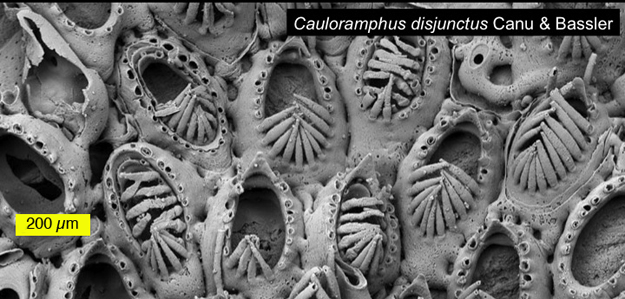KIEL, GERMANY–One of the most interesting presentations at this meeting of the International Bryozoology Association, at least to a paleontologist, was by my friend Paul Taylor (Natural History Museum, London). He described a fauna of bryozoans which inhabited cobbles in a cold-water submarine channel in northern Japan during the Pleistocene (roughly 0.50 to 1.25 million years ago). The cobble-bearing unit was exposed by tectonic action as dry land and forms a deposit colloquially known as “Kokemushi Paradise”. Kokemushi is the delightful Japanese term for bryozoan.

One of the cobble-encrusting bryozoans under a scanning electron microscope. Note how many of the exquisite little spines are preserved in place.
There are 120 species of bryozoans on these igneous cobbles, which is an extraordinary diversity. Every cobble is encrusted, some with up to 25 species. There are also barnacles, corals, foraminiferans and serpulid worms. For a specialist in hard-substrate faunas (“sclerobionts“), this is a paradise indeed.

The vertical tubes are termed "peristomes" and they extend from the bryozoan apertures. Such delicate structures are rarely preserved in fossils.
When a limited hard surface like that of a cobble is occupied by diverse and abundant sessile organisms, there is inevitably a competition for living space. This competition is recorded in the fossil record by the overlapping of skeletons as one species overgrew another. The Kokemushi Paradise bryozoans show many examples of such space competition. It is not always a simple system of one species always overgrowing another. Sometimes two species will mutually overgrow each other.
The Kokemushi Paradise site is, alas, lost to development, but there are hundreds of cobbles preserved in the Natural History Museum in London. Maybe someday a Wooster Independent Study student will get the chance to examine them in paleoecological detail!





The SEM images are phenomenal! I’m impressed by the detail. And Kokemushi is my new favorite word. Thanks for sharing!